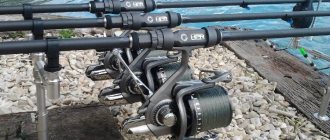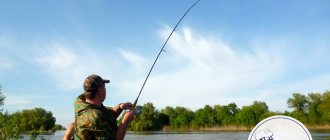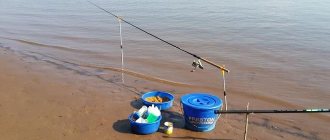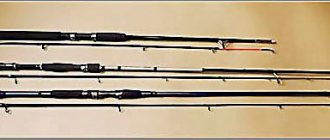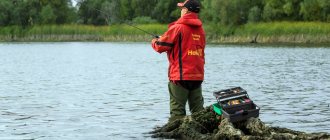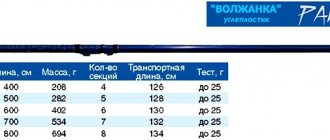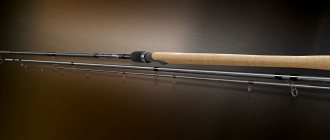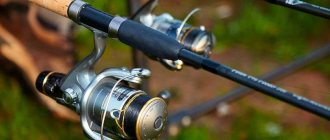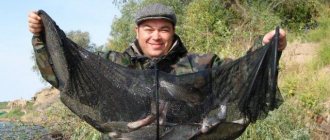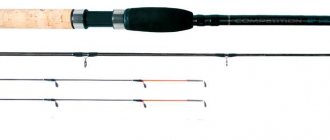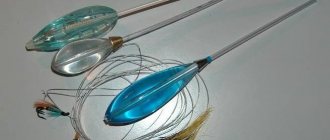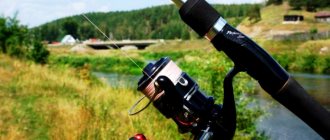"Telescope" or "plug"?
According to their design, feeder rods are divided into two types: • Telescopic feeder – a folding rod. It starts with a section of larger diameter and ends with a section of smaller diameter. This structure allows you to quickly expand or fold the feeder. For the same reason, the rod is characterized by increased structural rigidity. • Plug feeder – a collapsible fishing rod. It consists mainly of three elbows connected to each other. It is large in size and less convenient to transport. Unlike telescopic, it can be of different constructions. Experienced anglers prefer the “plug”. Its advantages include: greater convenience in the process of casting and fishing, the ability to install rings where necessary. In the “telescope”, due to the design features, the rings are installed only at the end of each section at the joints. Also, a plug rod has increased strength and is lighter than a telescopic rod. If you are choosing a feeder for infrequent amateur fishing with outdoor recreation, choose a “telescope”. It is easier to transport and store.
Differences between a telescopic feeder and a plug feeder
When purchasing a telescopic feeder rod, an angler must understand that it is unlikely to have the same performance characteristics as plug-in models. Compact retractable feeder rods are not designed for high-speed fishing of small fish, which is most often practiced in competitions, because they have a large mass and are not fast enough.
The telescopic option is better suited for those anglers who are just starting to master feeder fishing and prefer to catch the following fish:
The length of “telescopes”, as a rule, is slightly longer than the length of plug-in products, and starts from 3.2 m. Unlike professional feeders, retractable fishing rods are rarely made of high-modulus graphite. The main material for making the blank is fiberglass, which is why the mass of the “telescope” is significantly greater than the weight of the “plug”. The handle of retractable fishing rods is often made of synthetic materials, rather than cork, like plug-in models.
The fittings that the “telescopes” are equipped with are inferior in quality to those used in two-piece fishing rods, so you will have to abandon the use of very thin “braid”. A thin braided cord will quickly damage the guide rings, and fishing will become impossible. For fishing with a telescopic feeder, a rigid monofilament line with a low stretch coefficient or a “braid” with a diameter no thinner than 0.12 mm is better suited. Among retractable feeder rods, there are rarely those whose actual test weight is less than 40 g, which requires the use of rather heavy feeders.
Almost all “telefeeders” are equipped with replaceable tips made of fiberglass. Fiberglass quivertypes have a large mass. This negatively affects the sensitivity of the gear.
Feeder rod material
The feeder is made of carbon fiber or fiberglass. There are also composite fishing rods. Each of the materials has its pros and cons: • A composite fishing rod is quite durable and, if handled correctly, will serve for many years. Disadvantages include greater weight compared to other materials and stiffness. • Carbon fiber rod – preferred by experienced fishermen due to the best sensitivity. But it also has its downside - a high price. • Fiberglass rod - cheaper than carbon fiber, but less strong and reliable, and also heavier. Experienced fishermen recommend exclusively carbon fiber because of its reliability and sensitivity. In their opinion, it is better to pay once for a durable and light fishing rod than to regularly buy a new one. Experienced fishermen recommend exclusively carbon fiber because of its reliability and sensitivity. In their opinion, it is better to pay once for a durable and light fishing rod than to regularly buy a new one.
How to choose a feeder rod
Before you go to the store to buy a feeder rod, you should answer a few simple but important questions. If this is your first experience, then it is better to opt for an inexpensive universal “stick”. As the angler gets to know the gear, he will have specific requirements for the rod.
When casting equipment long distances, when fishing in the current, a feeder of greater length and test is required. You also need to take into account the size of the intended trophy. For example, to catch crucian carp in a pond, a more delicate rod is required than when fishing for carp and carp.
It is important for the fisherman to take into account the number of trips to the reservoir. It’s one thing when a person goes fishing 2-3 times a year, and the rest of the time an expensive fishing rod gathers dust in the closet. But if an angler spends every weekend or entire vacation on a river or lake, then the use of a professional feeder rod is justified.
The main parameters that characterize the feeder rod are:
Rod test
Each rod is designed for specific fishing conditions. In order to optimally use the properties of the feeder, the weight of the thrown load is indicated on the form of the rod or there is an inscription that indicates the maximum loads.
- The inscription Light means that the rod is light, it can cast equipment weighing up to 30 g;
- Medium-Light speaks of using feeders weighing up to 60 g;
- Medium – from 60 to 80 g;
- Medium-Heavy – from 80 to 100 g;
- Heavy – from 100 to 120 g;
- Extra-Heavy – over 120 g.
Using feeders with lighter weights will negatively affect the sensitivity of the feeder, and exceeding the test limit increases the likelihood of rod breakage.
Rod length
Currently, rods are produced with lengths from 2.7 to 4.8 m in increments of 0.3 m. Some English models have their own length scale.
The most common are feeders with a length of 3.6 to 3.9 m. Such fishing rods are convenient for casting rigs over long distances.
In addition, these rods give you complete control over your rig. To cast bait over long distances, a rod more than 4 m long is required.
In some models of feeder rods, it is possible to increase the length due to an additional elbow. Thus, the angler will actually have two fishing rods of different lengths.
Rod material
Feeder rods are made from three main materials:
- carbon fiber;
- fiberglass;
- composite (a mixture of “glass” and “coal”).
Carbon fiber. Despite the fact that carbon fiber is considered a modern material, it has certain disadvantages.
The most important of them is the high cost of the rod.
The second disadvantage of carbon is the delicacy and fragility of the product. Therefore, experienced and careful fishermen should buy a high-quality carbon fiber rod.
Composite For beginner feeders, a “stick” made of composite material will do just fine. Although such a rod will be somewhat heavier and stiffer, it will last a long time.
Fiberglass. In extreme fishing conditions (extreme casting, heavy feeders, catching large fish), the use of fiberglass rods is justified.
Choosing a spinning rod - what characteristics to look for, detailed review.
Build
According to their structure, feeders are divided into four categories: • Fast – “Fast”. The toughest of all. Only the first leg and the top of the rod bend. • Average – “Medium”. Less rigid feeder, bends 1/6 of the rod length. • Slow – “Slow”. The softest rod, the entire body bends right up to the handle. • Complex – “Progressive”. This rod bends with its entire body, but according to an increasing principle. At the very beginning, the upper part goes to bend, and with increasing load, all other parts of the rod are gradually included in the work. The second name for such a feeder is “parabolic”. The advantage of a fast action is the ability to hook fish quickly and sharply. A slow action rod makes it easier to catch large fish. Telescopic rods come in only fast and medium action.
Feeder test
The test refers to the weight of the casting gear with the feeder. Depending on the test, rods are divided into classes: • “Light” – casting weight of the tackle is 30 grams • “Medium Light” – casting weight of the tackle is 60 grams • “Medium” – casting weight of the tackle is from 60 to 80 grams • “Medium Heavy” – castable tackle weight from 80 to 100 grams • “Heavy” – casting tackle weight from 100 to 120 grams • “Extra Heavy” – casting tackle weight over 120 grams Experienced fishermen recommend choosing a fishing rod with a small “margin” from the planned weight of the casting tackle.
Best models
Different fishing conditions require different rod models.
For fishing on small rivers, the best option would be a feeder with a length of 3.3 to 3.6 m with a test weight of up to 80 g, semi-parabolic or fast action.
Fishing on a large river will require a “stick” with a length of 3.6 to 4.2 m with a test of 80-150 g of fast action.
When fishing on stagnant lakes, it is better to use semi-parabolic or parabolic rods with a test weight of 30 to 100 g and a length of 3.3-3.9, depending on the fishing distance. If fishing is done from a boat, then a feeder rod 2.7-3 m long with a test weight of 20-50 g is best suited.
Feeder rod length
When choosing the length of the feeder, you should take into account the conditions under which the fish will be caught. Conventionally, rods can be divided into: • “Light” – rod length up to 3.3 meters, casting distance up to fifty meters. These feeders are designed for fishing on medium-sized ponds and lakes, as well as rivers with weak currents. • “Medium” – rod length 3.6 meters, casting distance up to sixty meters. These feeders are more universal, designed for fishing on lowland rivers, as well as reservoirs, ponds and lakes. Also suitable for fishing from a boat. • “Heavy” – rod length from 3.9 to 4.2 meters, casting distance up to eighty meters. These feeders are designed for fishing on large lakes and rivers with power casts over long distances of heavy tackle. • “Super heavy” – the length of the rod in some models exceeds five meters, the casting range is over one hundred meters. Used for ultra-long casting of the heaviest tackle. Short rods are called picker rods. Pickers are divided into: • “Ultralight” and “light” – length up to 2.4 meters, test from 3 to 20 grams. • “Medium” – length from 2.4 to 2.7 meters, test from 30 to 40 grams. • “Heavy” – length up to 3 meters, test from 100 to 110 grams.
Telescopic feeder
Feeder - a chance for the fisherman
In today's hectic world, it is extremely important to be able to abstract yourself from the hustle and bustle, take a break and give yourself a rest in peace and quiet.
Many people have long come to the conclusion that the best form of such recreation is fishing.
The ancient craft of fisherman, which for thousands of years had strategic importance and provided billions of people with food, is also a very popular hobby and way of spending leisure time today.
Today there are many types of fishing.
Experienced fishing craftsmen have been improving them for many years, sometimes arriving at quite unique, but no less effective options.
More than half a century ago, UK anglers used homemade feeders to catch fish. Most often it is used for catching fish that feed and live at the very bottom of the reservoir - primarily carp and bream.
One of the most important components of this fishing method is the correct and careful selection of a feeder rod. This article will publish some recommendations for its selection.
Choosing a rod
Feeder rods have gained popularity in our country not so long ago. In essence, they are modernized donks. Bottom rods themselves were a rather clumsy means of catching fish. Modern fishermen use technologies that include only the best functions and qualities.
When choosing feeder rods, you need to take into account several important parameters:
1. Rod length.
One of the most important criteria. The casting distance directly depends on the length of the rod.
Advice
In addition, a feeder with a long rod allows you to quickly lift the feeder from the bottom of the reservoir, which, in turn, significantly reduces the likelihood of it getting caught.
Today, models are known in the length range from two to five meters. Special attention should be paid to the transport length, on which the ease of moving the feeder depends.
Experienced fishermen have several feeder rods of different lengths.
For example, if fishing is carried out in a small and densely overgrown reservoir, it is more advisable to use the so-called picker - a more compact and lighter type of feeder with a shortened handle.
It is easier to use when casting short distances in shallow waters. Typically, with such equipment, fishing is carried out for crucian carp, white bream, rudd and other small fish.
2. Feeder test.
The test is a characteristic of the strength of the whip, equal to the range of possible weights of the baits. Manufacturers indicate a numerical range that determines what weight of bait will be optimal when using this particular rod. According to the test, feeders are divided into:
– light (weight range up to forty grams), used for fishing in shallow standing waters (pickers);
– medium (weight range from forty to eighty grams), used in reservoirs with standing water or weak currents;
– heavy (weight range from eighty to one hundred and twenty grams), used in the presence of strong water flow;
– extra-heavy (weight range from one hundred and twenty grams), which are used for fishing in reservoirs with strong currents when casting long distances.
3. Build a feeder.
A characteristic showing how much the rod bends when loaded. There are fast and slow feeders. The fast action feeder bends at the top of the whip, and the slow action feeder bends approximately in the middle. The first is convenient for long casting and the presence of a strong current, the second has additional shock absorption when hooking and fishing for active fish.
4. Alarms.
To determine the beginning of a bite, brightly colored tips of varying hardness are used in the feeders. They are usually made of durable monolithic carbon fiber, since when biting they bear quite a large load. Signalers painted with fluorescent paint have recently become very popular.
5. Rings.
The guide rings of the fishing rod must be made of high-strength material - rather stringent requirements apply to them. The number of rings also plays a big role.
The more rings, the more evenly the load is distributed along the entire length of the rod. Another important point is the number of legs of each ring.
The most reliable rings are those with the largest number of legs – three.
Choosing a telescopic spinning rod. What to pay attention to
If the choice nevertheless falls on a telescopic rod, you should pay attention to the following details: • The rod test should be with a margin of the planned weight of the gear being cast. Since the telescopic feeder is less durable and reliable than the plug-in feeder, it is necessary to have a safety margin. • No play when unfolded. All knees after the rod is unfolded should stay tightly and rigidly in place. • Feeder material. Since the “telescope” is less reliable due to its design features, pay attention to the quality and reliability of the material. • Ring quality. Be sure to pay attention to this. The rings must be strong, securely fastened and absolutely smooth for the line to flow freely from the reel. • Reel holder. No backlash. The attached reel should sit tightly and securely in the holder.
The best manufacturers of telescopic feeder rods
Now we will present the five best manufacturers of telescopic feeder rods, whose products have gained great popularity.
Mikado
Good value for money. Telescopic models: • SILVER EAGLE TelePicker – length from 3 to 3.3 meters, test from 20 to 60 grams. Price: 1000 rubles. • FISH HUNTER TelePicker – length from 2.7 to 3.3 meters, test from 20 to 60 grams. Price: 900 rubles.
Salmo DIAMOND TELE FEEDER
It produces models in different price categories, from luxury to budget. The telescopic feeder is represented by the DIAMOND TELE FEEDER model - length 3.3 meters, test 120 grams. Price: 1600 rubles.
Daiwa
It produces feeder rods of excellent quality, in a telescopic version it produces the model TRIFORCE TELE FEEDER TF LG R 36T-AI - length 3.6 meters, test from 10 to 60 grams. Price: 2000 rubles.
Shimano
It produces good fishing rods of various models designed for the average price category. All fishing rods of this brand have earned high praise among anglers. Telescopic models: • Aernos Tele Feeder – length from 3.66 to 3.96 meters, test from 60 to 90 grams. Price: 6300 rubles. • VENGEANCE TELE FEEDER HEAVY – length 3.9 meters, test 110 grams. Price: 5500 rubles. • VENGEANCE TELE FEEDER MEDIUM – length 3.6 meters, test 100 grams. Price: 5300 rubles.
Telescopic feeder: device, material, advantages and disadvantages
Sports and Fitness November 11, 2018
The success of fishing depends on the correct choice of place on the reservoir, bait and bait, as well as on the quality of equipment. Today they no longer fish with dried reed stalks and bamboo sticks. The modern fisherman has reels, lines and, of course, rods.
Over the past decade, feeder topics have gained wide popularity. Fishing using feeders in England began 40 years ago. However, in Russia this direction is considered relatively new. However, on the shelves for feeder fishing there is a large assortment of special telescopic and plug-in fishing rods.
You will learn about what a telescopic feeder rod is from this article.
Getting to know the tackle
Feeder rods can be telescopic or plug-in. The telescopic feeder is a folding product with gradually decreasing section diameters. A plug feeder is a collapsible fishing rod, in the design of which 3 elbows are connected to each other.
Mostly plug fishing rods are large in size, which is why owners often have difficulties transporting them. This type of feeder is used mainly by professionals. The advantages of plug-in designs are that the fisherman can independently position the guide rings where it is convenient for him.
In a telescopic feeder, rings are installed at the junctions of sections. Judging by numerous reviews, this type of fishing rod is suitable for amateur fishermen.
About the design
According to experts, due to their large length, classic fishing rods are difficult to transport.
Judging by the reviews, fishermen who had to fish on boats experienced many difficulties, since it is very inconvenient to move along the river with 4-meter tackle. This problem was solved with the advent of telescopic feeders.
Structurally, they consist of several elbows on which passage rings are installed. The optimal number of elbows is from 4 to 6 pieces.
Video on the topic
About materials
According to experts, telescopic feeders are predominantly made of carbon. This material is the lightest and at the same time very durable. In addition, carbon fiber and fiberglass are used to produce fishing rods. Judging by the reviews, carbon fiber ones are more sensitive, but are more expensive.
Such feeders are often purchased by experienced fishermen. Fiberglass gear is not as strong and reliable, but is cheaper. Experts recommend that beginners opt for fiberglass feeders. There are also fishing rods made from composite materials. These products are quite durable and have a long service life.
The downside is their heavy weight and rigidity.
About the advantages and disadvantages of feeders
If we compare telescopic fishing rods with plug-in fishing rods, the former are much cheaper. In addition to their short transport length, telescopic fishing rods fold and disassemble much faster. With this rod you can fish both from the shore and from a boat. In addition to the undeniable strengths, these gears also have disadvantages.
First of all, this is a small test indicator, as a result of which it will not be possible to catch a large specimen. Loading capacity directly depends on the length of the fishing rod. The fact is that the larger it is, the more elbows there are in the structure, and therefore the greater the load on the form will be. The optimal length for a telescopic rod is 3 meters.
For this reason, the fisherman is deprived of the opportunity to fish at long distances, which is also a disadvantage.
What models do experts recommend?
For those who don’t know which telescopic fishing rod-feeder is best to buy, experienced fishermen recommend paying attention to the following models:
- The Japanese company Mikado produces telescopic Silver Eagle. The length varies between 3-3.3 m. The test value is within 20-60 g. The telescopic feeder costs 1 thousand rubles. The company produces Fish Hunter rods. The line is represented by products with lengths from 2.7 to 3.3 m. Fishing rods are designed for loads from 20 to 60 g. You can purchase it for 900 rubles.
- Salmo Diamond Tele Feeder. Budget 3.3-meter telescopic fishing rods with a test weight of up to 120 g. You will have to pay 1,600 rubles for the feeder.
- Mega Tele Feeder (TF) from Banax. The size of the product reaches 3.3 m, the test varies between 30-90 g. It costs 4,300 rubles.
- TF LG R 36T-Al from Daiwa. The length of the telescopic feeder is 3.6 m. Load capacity is 10-60 g. Cost: 2 thousand rubles.
- Aernos TF Shimano. Length: 3.66-3.96 m, test 60-90 g. The rod costs 6,500 rubles. This manufacturer produces a four-meter telescopic feeder fishing rod Vengeance Heavy TF with a test value of 110 g. You can purchase it for 5,500 rubles.
- Telescopic feeder Kaida Spirado TF. The rod weighs 395 g. Length 3.6 m, load capacity from 60 to 120 g. The tackle is made of IM6 carbon. The design has 7 elbows. When folded, the fishing rod reaches 118 cm. Price: 10 thousand rubles.
Results
In conclusion, we will give some tips.
Once you have decided on the necessary characteristics of the feeder rod, material and brand, do not rush to buy it right away. Don’t rely only on the seller’s words, do a couple of simple tests for yourself: • Take the unfolded fishing rod in your hand. The grip should be comfortable for you personally. • Holding the rod in your hand, make movements that simulate casting, feel in practice the elasticity of the feeder, choose the one that you like best. • Visually carefully inspect and feel the rod for defects. When choosing a feeder, remember - the stingy pays twice. Source
